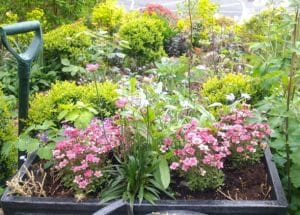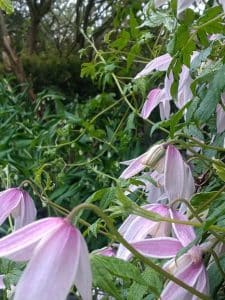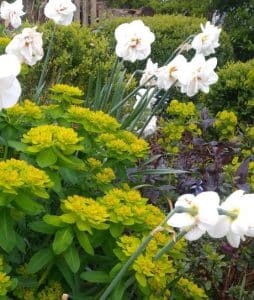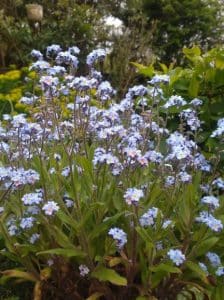The weather has turned a little cooler and wetter this week, and as the gardens put on some serious growth, there are plenty more Spring jobs waiting for you in the garden and greenhouse. The recent dry spell has left pots and new border plants rather thirsty, so a shower or three of rain will be gratefully received.
With more time than is usual, you’d think I would be well up to date….Alas. Too much energy spent wrestling with an ancient Honeysuckle, and not enough attention given to pruning the early forsythia and flowering currants. Because gardening is such a relaxing, calm activity (honeysuckle wrestling notwithstanding) I am frequently sidetracked mid task by something else that ‘needs doing.’ I suppose this is the very definition of ‘pottering’ and after all, that’s what us gardeners do best.
So, best boot forwards and potter on with this week’s jobs:
Pruning
Don’t be like me and neglect your Spring flowering shrubs. Daphne, forsythia and escallonia will benefit from a cut after flowering to promote a compact shape. Prune the flowering branches back several leaf buds to where the shoot is strong. Flowers form next Spring on the previous year’s growth, so pruning immediately after flowering will allow maximum time for new growth to form. Each year, cut out around 20% of older diseased or woody stems close to the plant’s base which will help prolong the life and health of deciduous shrubs. Always water and mulch the plant after pruning.
Planting out
Carry on hardening off your tender plants until the risk of frost has passed. If you have dahlia, begonia corms or canna tubers then these too can be planted out into the garden. Ensure that the soil is free draining and mulch with organic matter. Watch out for slugs and snails as soft new shoots push their way up through the earth.
Continue to sow poppy, nasturtium, sunflowers and cornflowers to provide colour later in Summer. And start thinking about Summer bedding plants, (although it may be more difficult to source these during the pandemic lockdown). If you do buy some then pinch out the growing tips to encourage bushier growth and more flowers. Don’t forget that annual bedding plants are notoriously thirsty throughout the Summer months.
Tidying up (a bit)
Any fading forget-me-nots or pulmonaria can be cut back and composted. Ignore any daffodil or other bulb leaves until they dry out completely allowing nutrition within the leaf to return to the bulb. Don’t even be tempted to tie them up! Instead, water the bulbs with a high potassium liquid feed to help them store food during dormancy. Some bulbs including Camassia and Alliums, send stalks and blooms skywards like fireworks, while their strappy leaves turn yellow disappointingly quickly. Faded and dry, they lurk untidily around the base of the stem detracting from the purple pom poms and blue spires above. An old gardening trick is to underplant the alliums with geraniums, cranesbill or other low growing, flowering plants, thus hiding the lower leaves from view.
While you’re pottering about, keep on top of the weeding with a few minutes worth each time you’re outside. This gives you the chance to have a good look at what’s occurring in your beds and borders, spotting any pests or diseases in good time and noting any staking, tying in or other jobs to go onto your ‘needs doing’ list.
Mow the lawn, scarify any moss, and feed/re-seed the grass as necessary. Trim around the border edges to finish off.
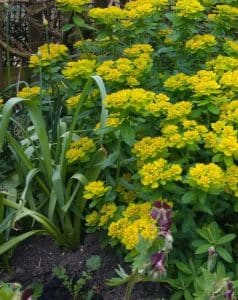
I perpetually seem to be adding homemade compost, well rotted manure and leaf-mould as mulch as it helps improve the texture of the heavy clay soil as well as directly feeding my plants by digging organic matter into each and every planting hole. Surface mulching helps soil to retain moisture during the Summer and promotes a healthy environment for helpful worms. You can also feed your plants by top dressing with a slow release fertiliser, especially around greedy roses and clematis.
If you grow fruit trees or bushes, then consider adding a fertiliser feed rich in nitrogen for overall growth, together with potassium for flowers/fruit and phosphorus for good root growth as well.
If you are gardening organically, then seaweed fertilisers are a brilliant choice. Always follow the instructions on the packaging before applying.
Loads to be getting on with, so take your time and appreciate your garden for all it gives you in return.



